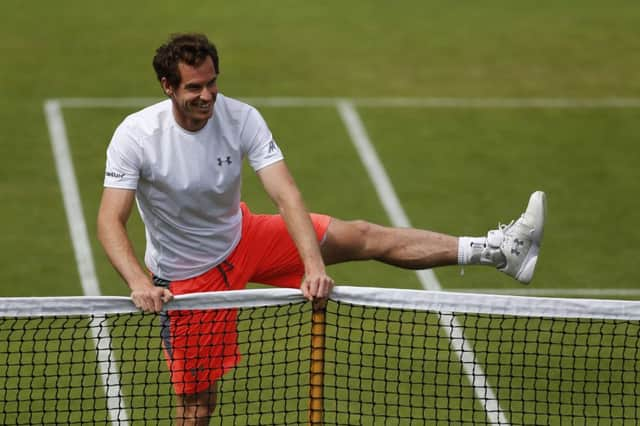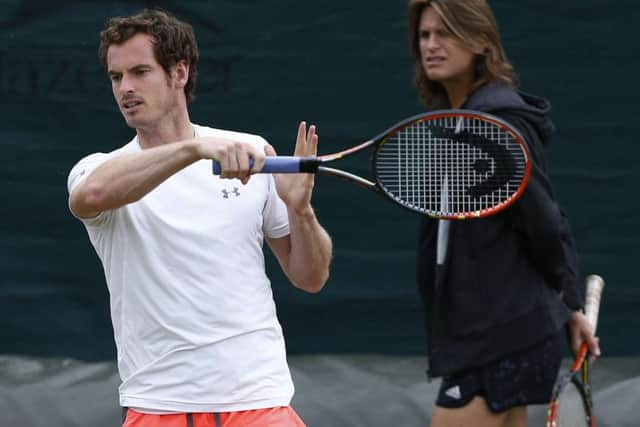Wimbledon: Andy Murray plotting perfect tenth


For the past week, the good and the great have been getting ready for the start of The Championships with some oh-so-jolly practice sessions out on Aorangi Park. Roger Federer has been inviting the young hopefuls to come and quiver in front of him (on Friday, it was the turn of Taylor Harry Fritz, the 17-year-old American, and even Federer admitted the young lad looked a little nervous).
Andy Murray, on the other hand, spent Thursday working out with Rafael Nadal and when he was not clobbering the Spaniard, he was high fiving him. To the casual observer, training with one of your nearest rivals – and a potential quarter-final opponent – does not seem to be the most logical way to prepare for the world’s most prestigious tournament. Murray, though, believes it is the perfect way to hone his skills and judge his form.
Advertisement
Hide AdAdvertisement
Hide Ad“I used to practise with Rafa all the time,” Murray said. “I haven’t practised with him so much lately because I was obviously injured for a while and then he was injured for a bit. It is good a few days before a major event starts to almost test yourself against one of the best players in the world because they will exploit things that you are not doing well.


“If you maybe practise with someone who is ranked 70 or 80, you can still have a great practice, and obviously they are fantastic players, but there are some things that you can maybe get away with, whereas if you are doing something badly and making the same mistake repeatedly against the best players, they punish you for that and that is why I think it is good sometimes to practise with the best.”
But all that will change from now on. From now on, the plans will be kept under wraps and the practice hours will give nothing away. The big boys will avoid each other until they are drawn to play on the match court – everyone is keeping their powder dry and the battle lines have been drawn.
“On an off-day between matches during a tournament there might be something in the match that you haven’t done well,” Murray explained. “You just want to have your own time to practise those things. Obviously, some of the days I will just hit with Jonas [Bjorkman, one of his two coaches] because I will just be able to do some of the things I didn’t think were going well or something I think might work in the next match. And you don’t always want all of the players, especially top guys, maybe players you might play at the end of an event, you don’t want them to know the things you are practising or working on so much. Whereas before the event when you are playing sets and stuff, it is good to play against them.”
Murray is an old hand at these pre-event routines now. It is a decade since he first stepped on to a show court at Wimbledon, a, young, spindly lad of 18 taking on George Bastl out on Court Two. From relative anonymity, his life was to change forever as he beat the Swiss, then ranked 146 in the world (Murray was 312), did likewise to Radek Stepanek, the world No 13, on Court One, and then took David Nalbandian, the 2002 finalist, to five sets on Centre Court. Murray was now a star – and a big one, at that.
“It was kind of everything that went with it that was extremely new to me,” Murray recalled. “I had never experienced big press conferences, people following me home. After the second match, I went out to play mixed doubles and I couldn’t get to the court. That was really weird for me because just a few weeks before, I was playing in front of five people. That is the kind of thing that sticks out for me when I think back then.
“I loved the matches on the court. There was no pressure on the court. Zero. No expectation but off the court it was actually more hectic than it is now. Sometimes I have the odd cameraman or photographer or whatever following me around but then it was worse.
“The pressure didn’t really build or change at all during that week. I didn’t really read the press at that age. I had no expectations myself and I think it doesn’t really matter what anyone else writes if you, in your heart, aren’t putting any pressure or expectations on yourself. So I just went out there and played and enjoyed it. It didn’t change for me during that tournament.”
Advertisement
Hide AdAdvertisement
Hide AdIt all changed in the years after, mind you. Now Murray’s every move is watched from afar, written about, photographed and dissected. And as an ex-champion, the expectations upon him are greater than ever, and yet there are no pressures greater than those which Murray places upon himself.
His build-up could not have gone any better – he is the champion of Queen’s (just as he was two years ago before starting his championship winning run), he has lost just one match in three months and he is one of the favourites for the title. Not that you would know: Murray is now in match mode and he is keeping his thoughts and his tactics to himself. We, like Mikhail Kukushkin, will only see how well they are working tomorrow.